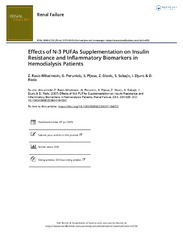Приказ основних података о документу
Effects of N-3PUFAs supplementation on insulin resistance and inflammatory biomarkers in hemodialysis patients
| dc.creator | Rasić-Milutinović, Z. | |
| dc.creator | Perunicić, G. | |
| dc.creator | Plješa, Steva | |
| dc.creator | Gluvić, Z. | |
| dc.creator | Šobajić, Slađana | |
| dc.creator | Đurić, I. | |
| dc.creator | Ristić, D. | |
| dc.date.accessioned | 2019-09-02T11:09:51Z | |
| dc.date.available | 2019-09-02T11:09:51Z | |
| dc.date.issued | 2007 | |
| dc.identifier.issn | 0886-022X | |
| dc.identifier.uri | https://farfar.pharmacy.bg.ac.rs/handle/123456789/935 | |
| dc.description.abstract | Aims/Hypothesis. It was suggested that polyunsaturated n-3 fatty acids (n-3 PUFAs) could improve insulin sensitivity and have an anti-inflammatory effects in overall population. This study investigates a possible effect of n-3 PUFAs supplementation on the insulin sensitivity and some inflammatory markers; hence, patients with chronic renal failure (CRF) on maintenance hemodialysis (MHD) are presented with insulin resistance. Methods. This study explored the ratio between red blood cells (RBC) phospholipid long chain fatty acids (LC FAs) and components of metabolic syndrome (MeS) in 35 patients (mean age 54.50 +/- 11.99 years) with CRF on MHD. Furthermore, the effects of omega-3 FA eight-week's supplementation (EPA+DHA, 2.4g/d) on the MeS features and inflammatory markers TNF-alpha, IL 6, and hsCRP were examined. Results. Supplementation increased EPA and DHA levels in RBCs (p = 0.009 for EPA and p = 0.002 for DHA). Total n-6 PUFAs: n-3 PUFAs ratio tended to be lower after supplementation (p = 0.31), but not significantly. Data revealed a significant decrease of saturated FAs (SFA) (P = 0.01) as well as total SFA: n-3 PUFAs ratio during the treatment (P = 0.04). The values of serum insulin and calculated IR index-IR HOMA were reduced after supplementation (p = 0.001 for both). There was a significant decrease in the levels of all inflammatory markers (p = 0.01 for TNF alpha, p = 0.001 for IL 6, p = 0.001 for hsCRP, and p = 0.01 for ferritin). In multivariate regression analysis, only the changes in n-6 PUFAs: n-3 PUFAs ratio independently contributed to 40% of the variance in IR HOMA. The impact of changes in PUFAs level in RBCs membrane phospholipid fatty acids on inflammation markers was also registered. The changes in n-6: n-3 PUFAs ratio independently contributed to 19% of the variance in TNF alpha. Conclusion. It was concluded that the EPA and DHA moderate dose administration in the patients with CRF on MHD had a beneficial effect on insulin resistance decrease. The anti-inflammatory effects of the supplemented PUFAs were also presented. | en |
| dc.publisher | Taylor & Francis Ltd, Abingdon | |
| dc.relation | info:eu-repo/grantAgreement/MESTD/MPN2006-2010/145071/RS// | |
| dc.rights | openAccess | |
| dc.rights.uri | https://creativecommons.org/licenses/by-nc/4.0/ | |
| dc.source | Reproductive Toxicology | |
| dc.subject | end-stage renal disease | en |
| dc.subject | insulin resistance | en |
| dc.subject | n-6 PUFAs | en |
| dc.subject | n-3 PUFAs | en |
| dc.subject | inflammatory marker TNF-alpha | en |
| dc.title | Effects of N-3PUFAs supplementation on insulin resistance and inflammatory biomarkers in hemodialysis patients | en |
| dc.type | article | |
| dc.rights.license | BY-NC | |
| dcterms.abstract | Пљеша, Стева; Перуницић, Г.; Ристић, Д.; Глувић, З.; Расић-Милутиновић, З.; Ђурић, И.; Шобајић, Слађана; | |
| dc.citation.volume | 29 | |
| dc.citation.issue | 3 | |
| dc.citation.spage | 321 | |
| dc.citation.epage | 329 | |
| dc.citation.other | 29(3): 321-329 | |
| dc.citation.rank | M23 | |
| dc.identifier.wos | 000246884800012 | |
| dc.identifier.doi | 10.1080/08860220601184092 | |
| dc.identifier.pmid | 17497447 | |
| dc.identifier.scopus | 2-s2.0-34248588309 | |
| dc.identifier.fulltext | https://farfar.pharmacy.bg.ac.rs//bitstream/id/2276/933.pdf | |
| dc.type.version | publishedVersion |

